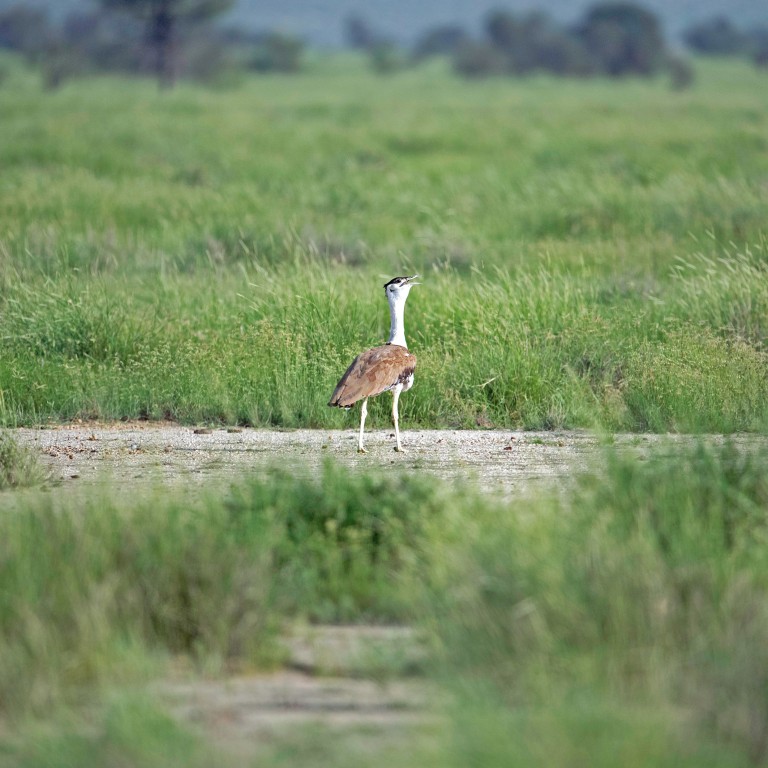
India conservationists up in arms over power lines that could kill endangered bird
- In the 1980s, India had about 1,500-2,000 Great Indian Bustards. Now, only 120-150 of them remain
- The bustard, once in the running for India’s national bird but lost to the peacock, has poor vision and is too heavy to change its flying direction at the last minute
Conservationists in India are up in arms over plans by the electricity regulator to allow power companies in northern Rajasthan state to proceed with projects that could endanger the Great Indian Bustard, one of the heaviest flying birds in the world.
The bustard has poor vision and is so heavy it cannot change its flying direction at the last minute. Failure to see overhead electricity lines in time results in almost certain electrocution and death. About 10 bustards are electrocuted every year across India.
Electricity officials are aware of the danger posed to the bird by these lines but say it will be mitigated by the installation of “bird diverters” – flaps hung on the overhead lines to act as reflectors – that allow birds to spot the lines from a distance and change its flight path.

But wildlife biologist Sumeet Dookia and environmental groups said the diverters would only reduce the mortality rate by around 10 per cent. Advocates also said the proposal violated several Supreme Court rulings aimed at preventing the species’ extinction, and they plan to ask the court to tell the regulator to withdraw its proposal.
The birds and the lines have been an issue since 2019, when the Supreme Court started hearing petitions from environmentalists demanding that power lines which criss-cross the bird’s habitat and move solar and wind energy to the grid, be moved underground.
These lines are increasing in numbers as India’s renewable energy companies commission more solar and wind power projects across Rajasthan, such as the Thar Desert. There are few large parcels of land suitable for solar and wind energy generation projects in India but the hot and vast Thar Desert is ideal for both.
Will India’s plan to revive cheetah population be a ‘waste of money’?
Last April, the court ruled that the alternative energy companies must move their lines underground. “There cannot be disagreement whatsoever that appropriate steps are required to be taken to protect the said species of birds,” the judges said in their ruling.
The court added that no new overhead transmission lines can be installed unless approved by one of its committees. Given this, conservationists are shocked at this month’s draft proposal by the electricity regulator stating that some lines will be installed overhead nonetheless.
In the 1980s, India had about 1,500 to 2,000 Bustards across eight western states. Bird watchers could see these massive birds – that have a wing span of seven feet – heave their heavy bodies off the ground like a Boeing 747 and take flight.
The bird was once in the running for India’s national bird but lost to the peacock, over concerns about misspelling “bustard”.
Now only 120 to 150 Bustards remain in India, mostly in Rajasthan and Gujarat.
A failure to protect grasslands where the birds nest, rampant egg collection and hunting have almost wiped out the species. The birds are also slow breeders, laying only one egg a year.
The birds make their nests in small depressions in grassland, rendering them vulnerable to stray dogs.
Renewable energy companies said that moving overhead power lines underground would increase the cost of new solar and wind projects by 20 per cent.
But Dookia said the companies only have themselves to blame.
“The issue has been in the courts for several years and in this time, the companies have persisted with laying overground lines when they shouldn’t have. It’s their problem if they now have an extra cost,” he said.
The situation is further complicated by India’s promise to increase the share of renewable energy to 50 per cent by 2030, under its climate change commitments.
Energy companies have claimed that the court’s rulings on overhead lines threaten to delay India meeting its climate change goals.


